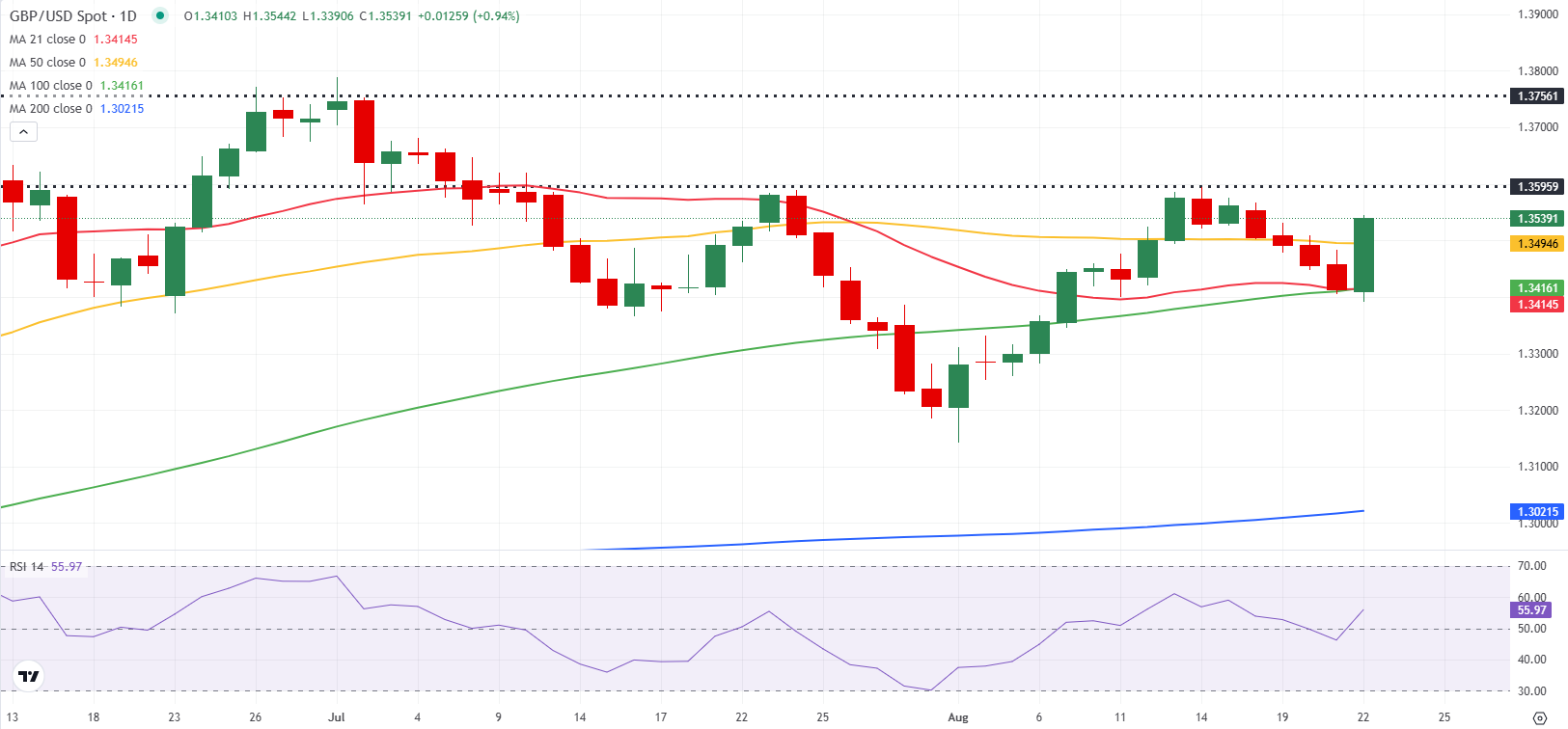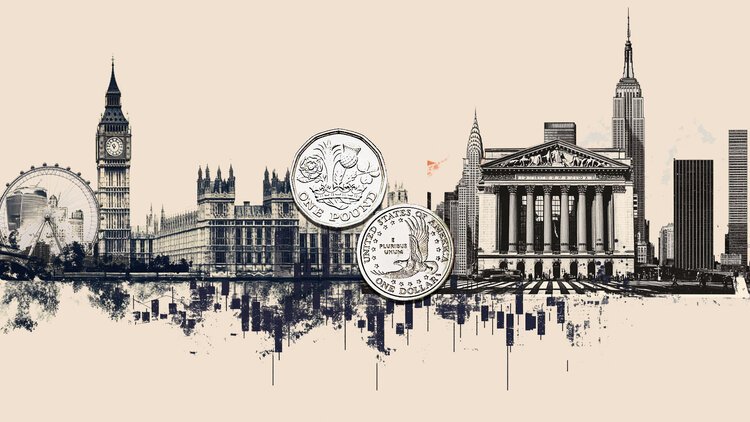- The Pound Sterling pulls back from monthly highs near 1.3600 against the US Dollar.
- GBP/USD braces for a holiday-shortened week, with US macro data to dominate.
- The daily technical setup points to sellers’ hesitancy following Friday’s recovery.
The Pound Sterling (GBP) faced rejection yet again, just shy of the 1.3600 mark against the US Dollar (USD), leading to a solid pullback in the GBP/USD pair from one-month highs to eight-day lows. However, the renewed USD weakness heading into the weekend opened the door for a decisive recovery in the pair.
Pound Sterling sellers reclaim control
A down week, overall, for GBP/USD, characterized mainly by a broad-based US Dollar resurgence until Federal Reserve Chairman Jerome Powell’s speech at the annual Jackson Hole Symposium.
Two primary catalysts, in risk aversion and reduced dovish sentiment around the US Federal Reserve, helped the Greenback stage a decent comeback against its major currency rivals.
The week kicked off with some USD weakness amid a risk-on mood, even as the weekend meeting between US President Donald Trump and Russian President Vladimir Putin in Alaska concluded without securing a Ukraine peace deal.
Hopes that Trump may lift sanctions on Russia and invest instead kept the broader market sentiment buoyed.
Risk flows gathered steam after US President Donald Trump and his Ukrainian counterpart Volodymyr Zelenskiy met late Monday and promised to end hostilities between Russia and Ukraine, paving the way for a potential trilateral meeting in the coming months.
Zelenskiy said security guarantees for his nation will likely be worked out within 10 days after talks with President Trump and European leaders.
However, sentiment on Wall Street continued to sour this week amid a steep sell-off in tech stocks, as investors remained concerned that American tech giants’ Artificial Intelligence (AI) investments were not delivering returns.
The negative shift in risk sentiment helped revive the safe-haven appeal of the US Dollar, while drawing additional support from the reduced odds of an interest rate cut by the Fed next month.
A recent slew of strong US economic data, including housing and business activity, helped markets reprice their Fed expectations.
US Existing Home Sales for July rose to 4.01M vs. 3.92M expected, having rebounded 2.0% on the month after a 2.7% decline in June.
Meanwhile, the headline S&P Global US PMI Composite Output Index rose to an eight-month high in August, ticking up from 55.1 in July to 55.4, while the Manufacturing and Services PMIs beat estimates, with 53.3 and 55.4, respectively, in August.
Markets pared back bets for a September Fed rate cut to 75% post-US PMI data, according to the CME Group’s FedWatch Tool, from about 85% seen pre-release.
Furthermore, markets remained expectant that Fed Chair Jerome Powell to stick to the cautious stance on further easing during his opening remarks at the Jackson Hole Symposium on Friday.
Nick Timiraos of the Wall Street Journal (WSJ), the Fed whisperer, said on Thursday that Powell could “reverse two major 2020-era policy changes; flexible inflation averaging and a bias toward low unemployment.”
This narrative infused fresh life into the Greenback before things changed heading into the weekend.
While speaking at the annual Jackson Hole Symposium, Fed Chair Jerome Powell announced that they will adopt a new policy framework of flexible inflation targeting and eliminate ‘makeup’ strategy for inflation. Commenting on the economic outlook, Powell said that downside risks to the labor market were rising and added that it would be reasonable to expect that inflation effects of tariffs will be short-lived. These comments triggered a selloff in the USD and allowed GBP/USD to erase a large portion of its weekly losses.
On the Pound Sterling side of the equation, UK Consumer Price Index (CPI) inflation for July picked up to its highest level since January 2024.
The annual headline UK inflation rate rose from 3.6% in June to 3.8% in July, while core inflation also increased to 3.8%. CPI also unexpectedly rose by 0.1% month-on-month (MoM) in July, versus June’s 0.3%
Strong inflation and growth numbers suggested that the Bank of England (BoE) could delay further easing. This enabled the Pound Sterling to retest the 1.3500 hurdle against the USD briefly. But buyers failed to sustain at higher levels.
US PCE inflation eyed amid a relatively light week
It’s a holiday-shortened week for Pound Sterling traders as the UK markets are closed on Monday in observance of the Summer Bank Holiday.
Britain’s economic calendar is devoid of high-impact data releases, and hence, the focus will remain on the US docket.
Monday will feature the mid-tier New Home Sales data from the US, while Durable Goods Orders and the Conference Board (CB) Consumer Confidence data will drop on Tuesday.
The event calendar is light on both sides of the Atlantic on Wednesday.
On Thursday, the second estimate of the US second-quarter Gross Domestic Product (GDP) will be published alongside the weekly Jobless Claims data, followed by the Pending Home Sales.
The Personal Consumption Expenditures (PCE) Price Index will take center stage on Friday, wrapping a relatively quiet week data-wise.
Apart from statistics, geopolitical and trade developments, along with speeches from Fed policymakers, will continue to entertain GBP/USD traders.
GBP/USD: Technical Outlook

GBP/USD’s daily chart points to bullish tilt in the near term, with the Relative Strength Index (RSI) indicator on the daily chart rising toward 60. Additionally, GBP/USD cleared the 50-day Simple Moving Average (SMA), located at 1.3500, after spending the majority of the week below this level.
GBP/USD could face the next resistance at 1.3600 before targeting July 4 high of 1.3681 and 1.3788 (July 1 high).
On the downside, 1.3500 (50-day SMA) now aligns as the first support level before the 21-day SMA and 100-day SMA confluence zone near 1.3410 and the round level at 1.3300.
Economic Indicator
Core Personal Consumption Expenditures – Price Index (YoY)
The Core Personal Consumption Expenditures (PCE), released by the US Bureau of Economic Analysis on a monthly basis, measures the changes in the prices of goods and services purchased by consumers in the United States (US). The PCE Price Index is also the Federal Reserve’s (Fed) preferred gauge of inflation. The YoY reading compares the prices of goods in the reference month to the same month a year earlier. The core reading excludes the so-called more volatile food and energy components to give a more accurate measurement of price pressures.” Generally, a high reading is bullish for the US Dollar (USD), while a low reading is bearish.







